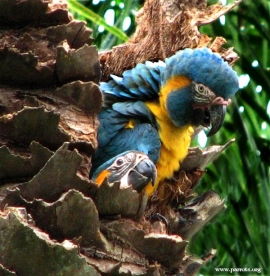Blue-throated Macaw |
|
|
Also known as: Wagler's Macaw, Caninde Macaw
Photos
View in GalleryDid You Know?
The Blue-throated Macaw regularly comes to Tabebuia trees for bill cleaning, made evident by telltale wearing of the tips of branches on this tree.Programs & Projects
WPT has worked with numerous partners to help save this species. Learn moreAcademic Research
Related publications: Ara glaucogularisSpecies Profile
Genus: Ara | Species: glaucogularis
Size:
85cm (33.1 in)
Weight:
750g (26.2 oz)
Subspecies including nominate:
one
Colour Adult:
Both adults turquoise-blue above, mostly yellow underneath with wide blue throat-patch and narrow yellow stripe on side of neck; tail blue; bare cere and face white with wide green/blue feathered stripes. Bill grey/black. Eye yellow.
Colour Juvenile:
As in adults, but with darker throat band; shorter tail. Eye grey.
Call:
Alarm call loud and raucous, but higher pitched than the Blue-and-yellow Macaw.
Listen NowVideo Links:
Video 1 | Video 2More Information:
Content Sources:
CITES
BirdLife International
Cornell Lab of Ornithology/Birds of the World
A Guide to Parrots of the World, Juniper and Parr, 1998
ML Media Collection Catalogue 132527, Blue-throated Macaw Ara glaucogularis, Hosner, Peter, El Beni, Bolivia, Jan. 16 2007, Cornell Lab of Ornithology. Site
Parrots: Status Survey and Conservation Plan 2000-2004, Snyder, McGowan, Gilardi and Grajal, 2000.
Parrots of the World, Forshaw and Cooper, 1989.
Vanished and Vanishing Parrots, Forshaw, 2017.
Parrots of the World, Forshaw, 2006.
Parrots in Aviculture, Low, 1992.
Psittacine Avicuture, Schubot, Clubb and Clubb, 1992.
Photos
View in GalleryDid You Know?
The Blue-throated Macaw regularly comes to Tabebuia trees for bill cleaning, made evident by telltale wearing of the tips of branches on this tree.Programs & Projects
WPT has worked with numerous partners to help save this species. Learn moreAcademic Research
Related publications: Ara glaucogularisSpecies Care
Captive Status:
Rare
Longevity:
50+ yrs
Housing:
A large enclosure 15m (49 ft) long in off breeding season - keeping permanently indoors not recommended.
Diet:
Soaked or sprouted sunflower seed, walnuts, peanuts, pecans, Brazil nuts and pine nuts; fresh corn, cooked maize; fruits such as banana, oranges, palm fruits if possible, nutritionally complete kibble for macaws.
Enrichment:
Large aviary (4 x 3.6m or 13.1 x 11.8 ft) with tree trunk in middle decorated weekly with fresh branches of pine, fir or eucalyptus, large chewable toys made for macaws, bowls for bathing.
Nest Box Size:
Horizontal box, 16" x 16" x 48" (40.6cm x 40.6cm x 122cm) with hole in one end.
Clutch Size:
2 or 3
Incubation Time:
26 days
Fledging Age:
13-14 weeks
Hatch Weight:
18g (0.6 oz)
Peak Weight:
670-830g (23.4-29 oz)
Weaning Weight:
600-700g (21-24.5 oz)
Photos
View in GalleryDid You Know?
The Blue-throated Macaw regularly comes to Tabebuia trees for bill cleaning, made evident by telltale wearing of the tips of branches on this tree.Programs & Projects
WPT has worked with numerous partners to help save this species. Learn moreAcademic Research
Related publications: Ara glaucogularisSpecies Wild Status
World Population:
312-455
IUCN Red List Status:
Critically Endangered
CITES Listing:
Appendix I
Threat Summary:
A BirdLife 'restricted-range' species. Historical trapping for international trade, predation, parasitism and disease of adults and chicks and hunting for feathers and meat. Growing threat from Africanised bees (Apis millifera scutellata). Competition for nest sites from similar macaw species also a concern. Low recruitment of breeding pairs into populations is a significant challenge.
Range:
Llanos de Mojos, Beni department, NC Bolivia, and a small population in the Municipal Protected Area of the Great Tectonic Lakes of Exaltación.
Habitat:
Found in flooded savannas, palm forest 'islands' and species-poor tropical forest in wet lowlands. Up to 300m (984 ft).
Wild Diet:
Pulp of fruits of Attalea and Acrocomia palms, occasionally opening unripe Attalea nuts to drink liquid.
Ecology and Behaviour:
Presence in any area depends on availability of palm fruits. Generally occurs in pairs although will roost with others, and possibly with Blue-and-yellow and Red-and-green Macaws.
Clutch and Egg Size:
2 or 3 elliptical eggs, 55 x 46mm (2.1 x 1.8 in).
Breeding Season:
August-December. Nest is in tree hollow.
Photos
View in GalleryDid You Know?
The Blue-throated Macaw regularly comes to Tabebuia trees for bill cleaning, made evident by telltale wearing of the tips of branches on this tree.Programs & Projects
WPT has worked with numerous partners to help save this species. Learn moreAcademic Research
Related publications: Ara glaucogularisMembers Only Resources
Please log-in now to find more research, resources and tools.
Not a Member?
Find more great information:
Gain exclusive access to 600+ pages of additional research, seminars and podcasts, specialists to ask your toughest questions, and dozens of other fun resources - when you become a WPT member.
Join Today >>

































